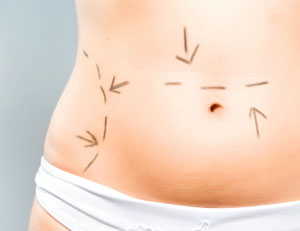The body contouring procedure normally follows extreme weight loss due to diet and exercise over the course of one to two years or gastric bypass surgery. Body contouring after weight loss is the combination of a lower body lift around the buttocks, groin, hips and thighs, mastopexy (breast), brachioplasty (arms) and adominoplasty (abdomen), and all of the surgeries are normally undergone in stages. Each of the individual procedures accounts for a anesthesia, facility or hospital, and surgeon’s fee, in addition to post-surgery garments, prescriptions and pre-surgical medical lab testing.
Throughout these procedures, the patient’s loose and sagging skin will be removed and the surgical areas will be cosmetically restructured and contoured. The skin is surgically cut away and remaining skin is connected and closed with dissolvable internal sutures and external stitches that are removed about a week or two after your surgery, or skin adhesives and surgical tape. Often, a drain is applied by inserting a tiny tube under the skin to collect excess fluid. Following the procedure, bandages are applied to the incision sites. Surgical areas are normally also wrapped to minimize swelling in compression garments.
Each area takes about one to two hours and the surgeries are considered outpatient procedures, meaning the patient may return home for recovery after an additional two to three hours of sleep following surgery. Usually, surgeons require that patients are safely driven to and from the facility or hospital and are cared for the first night following the surgery by another capable person.
Irreversible scarring is typically an unavoidable result of the surgery and the best candidates are men or women who are non-smokers as smoking affects scar therapy. Plastic surgery is a procedure that improves over time, optimal results are always seen well after bruising and swelling subside and in this particular extensive surgery it may take up to two years.
Risk and complications include, but are not limited to anesthesia risks, asymmetry, bleeding, blood clots, continuous swelling in the legs, fat necrosis, hematoma, infection, loss of nipple sensation, nerve, muscle, lung, blood vessel and/or vein damage, numbness, pain, severe wound separation and, as earlier stated, unpleasant scarring. Patients should be made aware that as the body ages skin toneness or firmness might result in a minimal loss. Hormone changes may also alter results and results will also vary if patient fails to maintain a stable weight.

